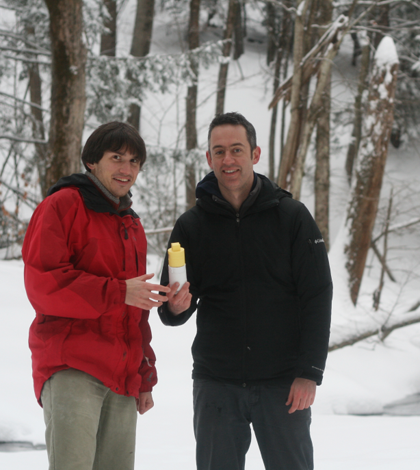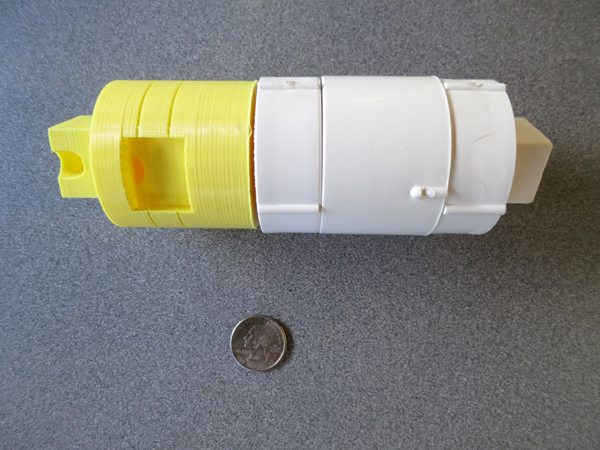Pursuing DIY, open-source water quality monitoring from rural Colombia to Mystic River, Mass.

Ben Gamari and Don Blair of the Open Water project with RIFFLE, their open-source water quality sensor (Credit: Don Blair)
In rural Colombia, small-scale mining operations often rely on toxic mercury to refine gold. The practice is taking a toll on environmental and human health in the region, but it may be a catalyst for an initiative to develop inexpensive, open-source water quality monitoring technology and the social systems necessary to get the most of out the equipment.
Don Blair is an organizer with Public Lab, an online community for do-it-yourselfers interested in environmental science. The lab hosts the Open Water project. The idea, Blair says, is to use open-source software and hardware to monitor water quality while building social structures around community education and outreach that allow for that to happen in a grass-roots way.
“The technology is going to change rapidly, but the thing that’s required if you really want a DIY, grassroots approach, you really need the social infrastructure around it,” Blair said in an interview from an open air cafe in Bogota, Colombia, where car horns and police whistles blared from the street nearby.
“I initially was geeking out about the hardware, but most of my time has now been spent essentially community organizing,” he said.
While Blair has been occupied by the social side of the project, his collaborators, including Ben Gamari, graduate student in physics at the University of Massachusetts Amherst, and Laura Dietz, a postdoc in computer science at the same university, have been plugging away on an inexpensive open-source water quality sensor. They’re calling it RIFFLE: Remote, Independent, and Friendly Field Logger Electronics. They have a prototype based on inexpensive sensors and freely available hardware plans and software, but plenty of development and testing remains before they reach their goal of a tool that can measure water conductivity, temperature and depth for months at a time.
“We have a working prototype that we haven’t even tested in a bucket, really,” Blair said. “We don’t even know if it will last more than a day at this point.”

A prototype RIFFLE enclosure (Credit: Public Lab)
Blair was in Bogota to meet with people from the Universidad de los Andes who were interested in implementing an inexpensive and community-driven monitoring program in rural Colombia. The experience made it clear that an endeavor like that would be much more complicated than just developing a simple, open-source sensor package and distributing it to affected communities.
Obstacles immediately come up around training citizens not only to use the sensors, but how to understanding data they’re collecting. Part of the ethos is citizens shouldn’t just be a sensors delivery and recovery system. They should understand and interpret data themselves and come up with their own investigations.
But that requires a lot of infrastructure around community outreach and education efforts, ideally targeting both rural areas where the monitoring is happening and urban areas to involve academic experts and government regulators.
Initially, Blair said, the Colombia project will aim “to leverage an open-source approach in order to enhance these environmental information flows from where the monitoring is happening, through some expertise to interpret it, and then back to the citizens.” But the ultimate goal, he said, is to enable “shorter loops — just citizens monitoring and then interpreting the data themselves.”
Closer to home, the Open Water project has watershed groups interested in what inexpensive sensors could do for citizen monitoring efforts. Blair said the Mystic River Watershed Association, for example, could benefit from an accessible conductivity sensor to measure the effects of road salt on water quality throughout the winter.
The RIFFLE team is developing citizen-scientist-friendly software that would make it simple to display and download data on a laptop through a USB connection. They’ll also likely seek input from the scientific community to help guide the development.
“At this point the next step is probably to both test it in a bucket for more than a day, and also get it in the hands of people who would be interested to use it so that we get feedback on what the best next development plans for it are,” Blair said.
Top image: Ben Gamari and Don Blair of the Open Water project with RIFFLE, their open-source water quality sensor (Credit: Don Blair)




0 comments